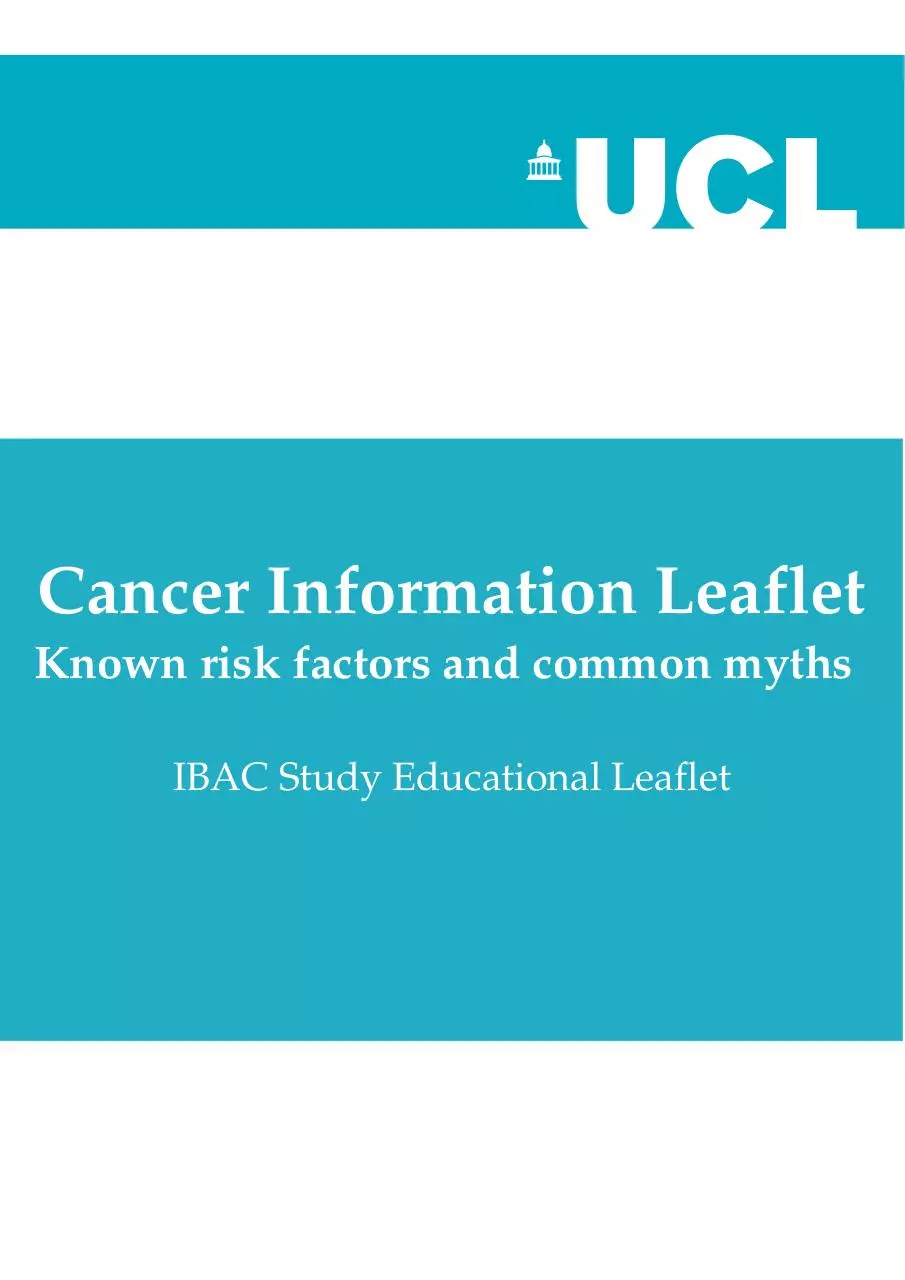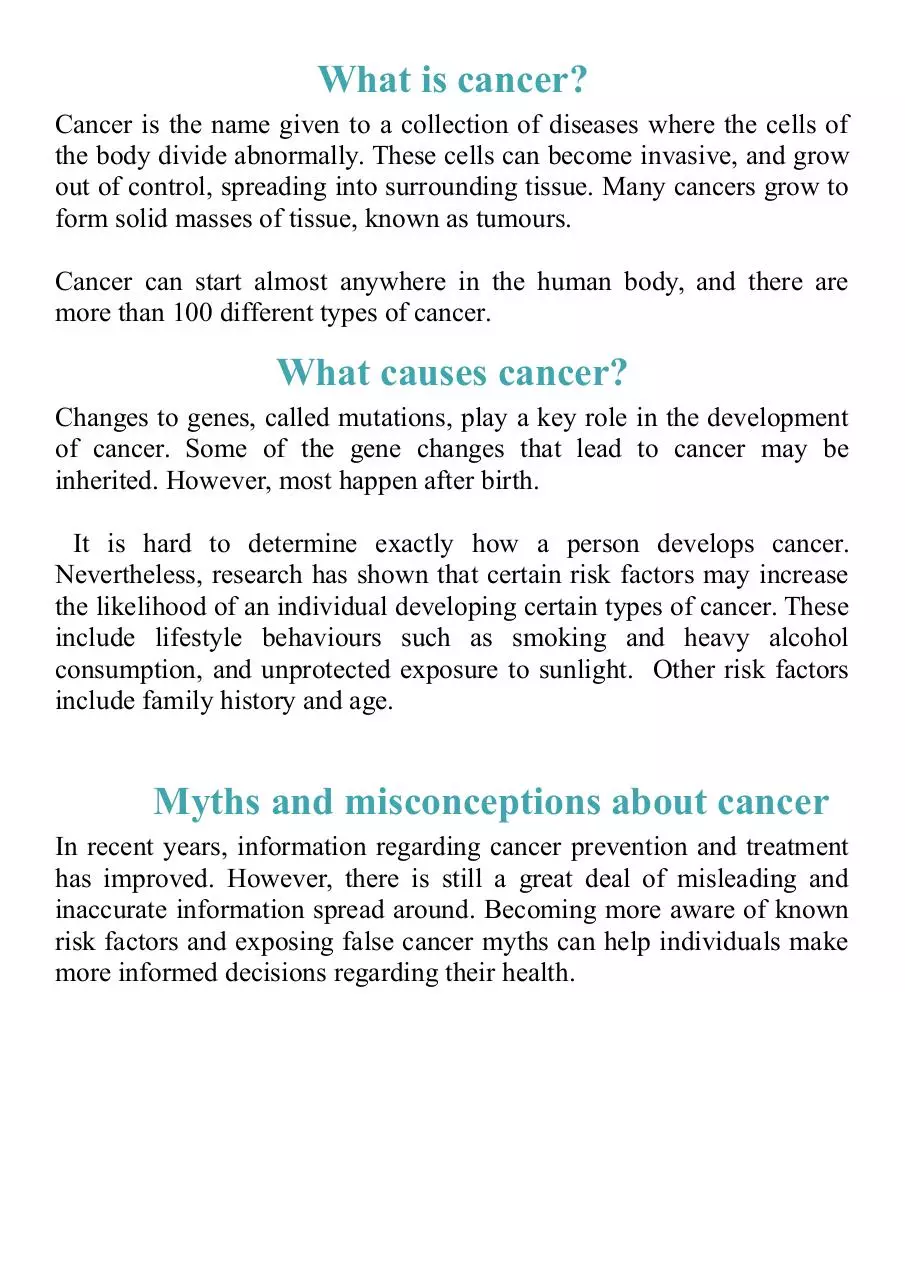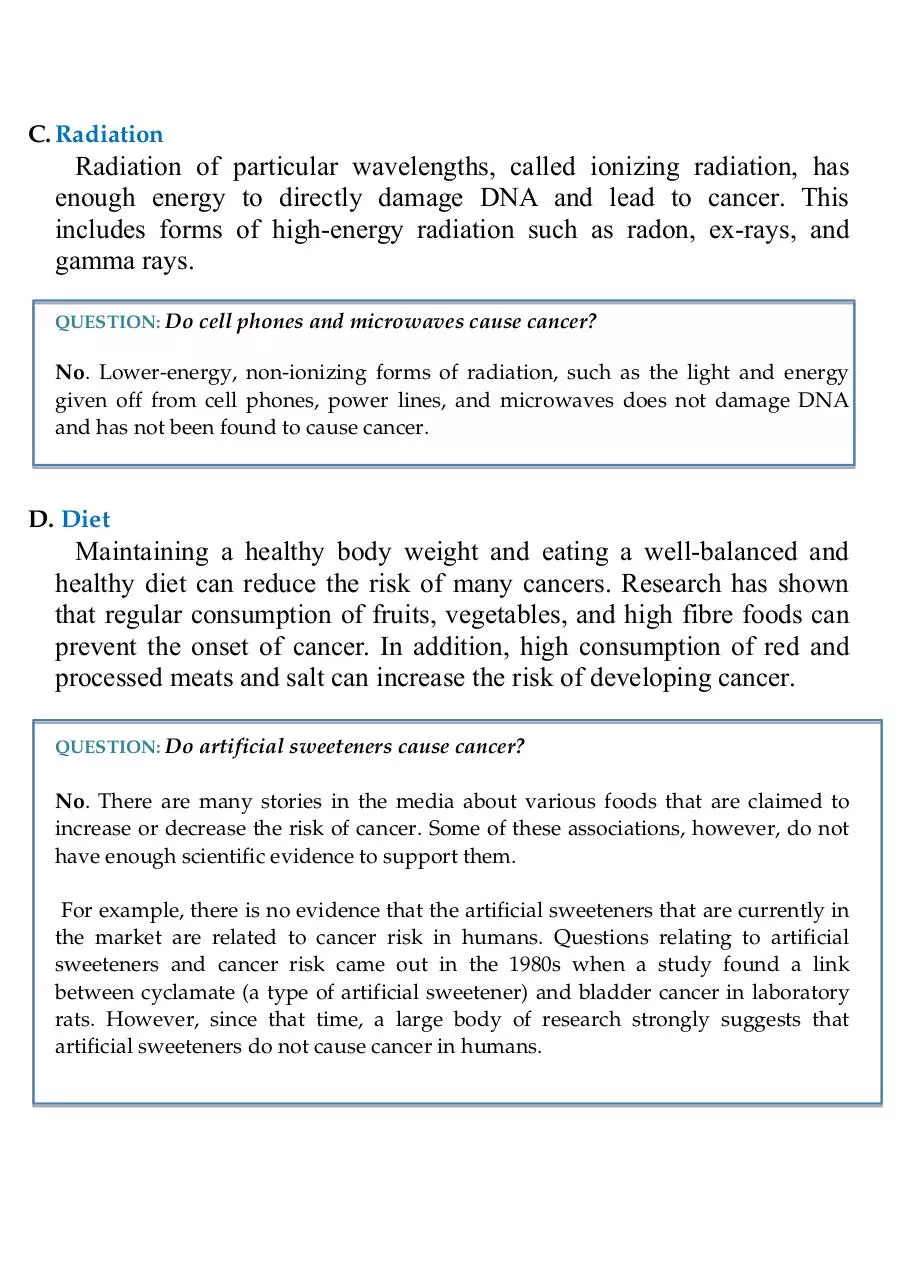Intervention dissertation NEW (PDF)
File information
Author: Emma Fox
This PDF 1.4 document has been generated by Writer / LibreOffice 4.4, and has been sent on pdf-archive.com on 13/05/2016 at 12:55, from IP address 94.3.x.x.
The current document download page has been viewed 315 times.
File size: 461.94 KB (4 pages).
Privacy: public file




File preview
Cancer Information Leaflet
Known risk factors and common myths
IBAC Study Educational Leaflet
What is cancer?
Cancer is the name given to a collection of diseases where the cells of
the body divide abnormally. These cells can become invasive, and grow
out of control, spreading into surrounding tissue. Many cancers grow to
form solid masses of tissue, known as tumours.
Cancer can start almost anywhere in the human body, and there are
more than 100 different types of cancer.
What causes cancer?
Changes to genes, called mutations, play a key role in the development
of cancer. Some of the gene changes that lead to cancer may be
inherited. However, most happen after birth.
It is hard to determine exactly how a person develops cancer.
Nevertheless, research has shown that certain risk factors may increase
the likelihood of an individual developing certain types of cancer. These
include lifestyle behaviours such as smoking and heavy alcohol
consumption, and unprotected exposure to sunlight. Other risk factors
include family history and age.
Myths and misconceptions about cancer
In recent years, information regarding cancer prevention and treatment
has improved. However, there is still a great deal of misleading and
inaccurate information spread around. Becoming more aware of known
risk factors and exposing false cancer myths can help individuals make
more informed decisions regarding their health.
Cancer prevention- myths and facts
The list below describes some of the known risk factors for cancer, and
highlights some common misconceptions and questions regarding these
risk factors.
A.Smoking
People who use tobacco products or are regularly around
environmental smoke (otherwise known as second-hand smoke) have an
increased risk of developing cancer. This is because tobacco products
have many chemicals inside them that directly damage DNA.
QUESTION: Is there use in quitting if a person has been smoking for a long time?
Yes. The damage done by smoking is cumulative, meaning that the longer an
individual smokes, the higher their risk of developing cancer. However, quitting at
any age brings immediate benefits. Ten years after quitting, former smokers cut
their risk of developing lung cancer by up to 50%.
B. Sunlight
The sun, tanning booths, and sun beds all give off ultraviolet (UV)
radiation. Exposure to these UV rays can cause skin damage and
increase the risk of getting skin cancer.
QUESTION: Are people with naturally olive or dark skin at risk of getting skin
cancer?
Yes. Although people with lighter skin have an increased risk of getting skin cancer,
anyone can burn if the sun is strong enough. The darker an individual’s skin, the
more melanin pigment they have, which protects the skin from UV rays, reducing
their cancer risk. However, this does not mean that people with darker skin cannot
get skin cancer. Often, people with darker skin will develop skin cancer on parts of
their body that aren’t usually exposed to the sun, such as on their palms or on the
soles of their feet.
C. Radiation
Radiation of particular wavelengths, called ionizing radiation, has
enough energy to directly damage DNA and lead to cancer. This
includes forms of high-energy radiation such as radon, ex-rays, and
gamma rays.
QUESTION: Do cell phones and microwaves cause cancer?
No. Lowerenergy, nonionizing forms of radiation, such as the light and energy
given off from cell phones, power lines, and microwaves does not damage DNA
and has not been found to cause cancer.
D. Diet
Maintaining a healthy body weight and eating a well-balanced and
healthy diet can reduce the risk of many cancers. Research has shown
that regular consumption of fruits, vegetables, and high fibre foods can
prevent the onset of cancer. In addition, high consumption of red and
processed meats and salt can increase the risk of developing cancer.
QUESTION: Do artificial sweeteners cause cancer?
No. There are many stories in the media about various foods that are claimed to
increase or decrease the risk of cancer. Some of these associations, however, do not
have enough scientific evidence to support them.
For example, there is no evidence that the artificial sweeteners that are currently in
the market are related to cancer risk in humans. Questions relating to artificial
sweeteners and cancer risk came out in the 1980s when a study found a link
between cyclamate (a type of artificial sweetener) and bladder cancer in laboratory
rats. However, since that time, a large body of research strongly suggests that
artificial sweeteners do not cause cancer in humans.
Download Intervention dissertation NEW
Intervention_dissertation_NEW.pdf (PDF, 461.94 KB)
Download PDF
Share this file on social networks
Link to this page
Permanent link
Use the permanent link to the download page to share your document on Facebook, Twitter, LinkedIn, or directly with a contact by e-Mail, Messenger, Whatsapp, Line..
Short link
Use the short link to share your document on Twitter or by text message (SMS)
HTML Code
Copy the following HTML code to share your document on a Website or Blog
QR Code to this page

This file has been shared publicly by a user of PDF Archive.
Document ID: 0000372101.